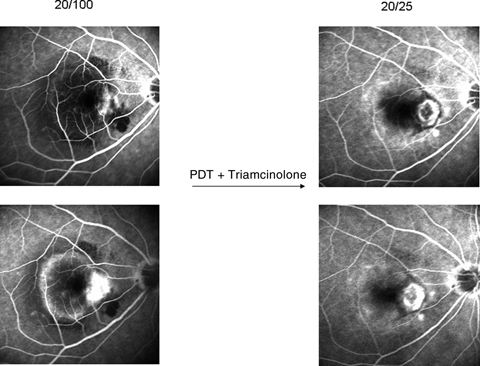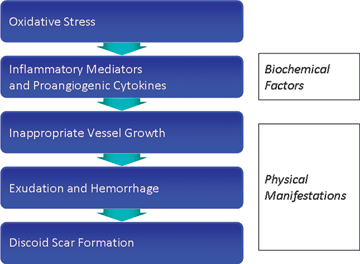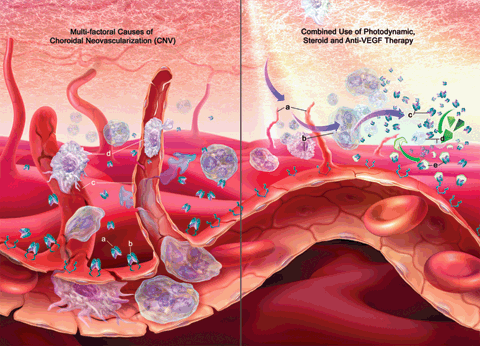Results: At the month 24 examination for the primary outcome, 53% of verteporfin-treated patients compared with 38% placebo-treated patients lost fewer than 15 letters. In subgroup analyses for predominantly classic lesions at baseline, 59% of verteporfin-treated patients compared with 31% placebo-treated patients lost fewer than 15 letters at the month 24 examination. For minimally classic lesions at baseline, no statistically significant differences in visual acuity were noted.
Conclusions: The visual acuity benefits of verteporfin therapy for AMD patients with predominantly classic CNV subfoveal lesions are safely sustained for 2 years. For minimally classic lesions, there is insufficient evidence to warrant routine use of verteporfin therapy (Bressler et al., Arch Ophthalmol. 2001;119:198).
VIP Study
Purpose: A randomized trial in patients with occult CNV secondary to ARMD and pathological myopia examined the efficacy of verteporfin treatment every 3 months versus sham treatment.
Results: At 12 months, there was no difference between two groups in terms of the primary outcome. At 24 months, a significant treatment benefit was seen in verteporfin treated eyes. About 54% of verteporfin treated eyes compared with 67% of placebo-treated patients lost at least 15 letters. About 4.4% of verteporfin treated eyes and none of the placebo-treated patients had a severe decrease of vision of 20 letters or more within 7 days of treatment, and this was attributed to the result of the development of subretinal pigment epithelial blood, marked subretinal fluid associated with choroidal hypofluorescence, or no obvious cause.
Conclusions: In patients with occult CNV, verteporfin therapy significantly reduced the risk of moderate and severe visual acuity loss. The VIP Study Group recommends that this therapy should be considered for the treatment of patients with AMD with subfoveal lesions composed of occult with no classic CNV who are presumed to have recent disease progression (VIP Study Group, Am J Ophthalmol. 2001;131:541).
VALIO STUDY: VERTEPORFIN WITH ALTERED LIGHT IN OCCULT CNV
Purpose: A Phase 2, multicenter, masked, randomized clinical trial to compare PDT therapy with verteporfin using either standard or delayed light application after the start of the infusion.
Conclusions: There were no significant differences between verteporfin therapy using the delayed light application regimen of 30 minutes or the standard light regimen of 15 minutes in eyes with occult with no classic CNV (Rosenfeld et al., Am J Ophthalmol. 2007;144:970).
VIM Study: Verteporfin in Minimally Classic CNV
Purpose: A Phase 2, multicenter, double-masked, placebo-controlled, randomized clinical trial to compare the treatment effect and safety of PDT using a standard (SF) or reduced (RF) light fluence rate with that of placebo therapy in patients with subfoveal minimally classic CNV with ARMD.
Conclusions: Verteporfin therapy safely reduced the risks of losing at least 15 letters (≥3 lines) of visual acuity and progression to predominantly classic CNV for at least 2 years in individuals with subfoveal minimally classic lesions due to AMD measuring 6 MPS disc areas or less. The VIM Study Group recommends verteporfin therapy for relatively small minimally classic lesions as were enrolled in the VIM Trial. There was no conclusive evidence of differences between the two verteporfin regimens identified (Azab et al., Arch Ophthalmol. 2005;123:448).
The current therapeutic gold standard is the anti-VEGF agent ranibizumab, a recombinant, humanized monoclonal antibody fragment that binds and inhibits the biologic activity of VEGF A.17 The rationale for the use of anti-VEGF drugs stems from the identification of angiogenesis as a leading culprit in neovascular and exudative eye diseases.18 In pivotal clinical trials, ranibizumab, given as a monthly intravitreal injection, was shown to improve visual acuity,19,20 with benefit in visual acuity maintained at 24 months.20
These results, showing the first meaningful vision improvement in significant numbers of patients with AMD treated with ranibizumab, also generated considerable off-label use of intravitreal bevacizumab.21–23 Bevacizumab is derived from the same recombinant humanized monoclonal antibody as ranibizumab, and is indicated for use in treating metastatic colorectal cancer, lung cancer, and breast cancer, because of demonstrated efficacy in inhibiting metastatic angiogenesis.24 Pegaptanib, the first anti-VEGF agent approved to treat CNV secondary to AMD,25 has largely been replaced by ranibizumab and bevacizumab as monotherapy with this class of drugs.
Other therapies, that is, laser photocoagulation and anecortave acetate, an indirect angiogenesis inhibitor, are appropriate in only a small minority of patients26 or are not available for use in North America and Europe, respectively. Their limited use precludes further discussion here.
As monotherapy, neither a steroid, verteporfin PDT, nor an anti-VEGF agent is able to treat the multifactorial pathogenesis of CNV. No single agent can reduce inflammation, eradicate existing CNV and inhibit further CNV, and limit VEGF expression. Thus, dual- and triple-combination therapies are being intensively investigated and increasingly used. Combination therapies with a verteporfin PDT component are the focus of this chapter.
Verteporfin PDT in Dual Combination Therapies
Verteporfin PDT and Triamcinolone
Among dual combinations, we have the most experience with verteporfin PDT plus intravitreal triamcinolone. In a prospective, comparative, nonrandomized trial, Chan et al. reported that a significantly higher proportion of patients treated with verteporfin PDT + triamcinolone did not develop moderate visual loss at 1 year compared with the PDT monotherapy group (71% vs. 33%, respectively, p = 0.009). Eyes treated with combination therapy had significantly fewer lines lost than eyes treated with monotherapy (0.7 vs. 3.5 lines, respectively, p = 0.015). None of the 48 trial participants developed ocular or systemic complications related to PDT. With combination therapy, there were transient increases in intraocular pressure but no serious complications such as endophthalmitis and retinal detachment.27
In a prospective randomized study involving 61 patients, verteporfin PDT + triamcinolone combination therapy was significantly better than PDT monotherapy in maintaining visual acuity (p = 0.001) and reducing lesion size (p = 0.001) and foveal thickness (p = 0.03). Combination therapy was also associated with a significantly lower retreatment rate (p = 0.04). Common ocular events included glaucoma (26%) and cataract progression (32%) and were considered triamcinolone-related.28 Case series have also reported good results for this combination, but glaucoma, cataract formation, and increased intraocular pressure have been noted.29–33 A representative case of a serous retinal pigment epithelium detachment and a small extrafoveal classic CNV treated with verteporfin PDT and triamcinolone dual combination therapy is shown in Figure 22.1.

FIGURE 22.1. Early and late phase angiography in a patient with a serous RPE detachment, small extrafoveal classic CNV, and basline visual acuity of 20/100. Following one administration of dual combination therapy, consisting of verteporfin PDT followed by 25 mg of crystalline triamcinolone acetonide injected intravitreally 16 hours later (Arias, et al. Ophthalmology. 2006;113:2243–2250), the lesion was dry and visual acuity increased to 20/25. At 24-month follow-up, the lesion remained dry. Note: At the time of treatment this was not an indication for PDT monotherapy according to TAP criteria. (Arch Ophthalmol. 1999;117:1329–1345) because the neovascular component covered less than half of the lesion area.
Verteporfin PDT and Anti-VEGF Agents
Dual combinations of PDT + anti-VEGF therapy are also of great interest. There is in vivo evidence from an animal model that PDT + ranibizumab may have synergistic effects. Real-time monitoring of angio-occlusion in the chick chorioallantoic membrane under conditions similar to clinical settings showed selective vascular closure with PDT and prevention of reperfusion of occluded vessels with topical application of the anti-VEGF agent.34
In clinical trials, the multicenter, randomized, single-masked, controlled FOCUS study found that PDT + ranibizumab was more efficacious than PDT alone in treating neovascular AMD. At 12 months, 95 of the 105 (91%) PDT + ranibizumab-treated patients and 38 of the 56 (68%) PDT monotherapy patients had lost fewer than 15 letters from baseline visual acuity (p < 0.001). PDT retreatment occurred significantly less in the combined therapy group. Ranibizumab treatment was associated with an increased risk of serious intraocular inflammation, possibly related to the trial’s use of an early formulation of this agent; nevertheless, affected patients on average still experienced visual acuity benefit.35
Clinical trial evidence also supports the administration of dual-combination therapy on the same day. Using PDT + bevacizumab, Lazic et al. showed increased visual acuity and fewer retreatments with combination therapy than with either agent alone after 1 month, with maintenance of these benefits at 3 months. Each therapy was given once on the same day in this randomized, controlled, open-label pilot trial (n = 165). Significant reductions in central foveal thickness occurred with all three treatments (p < 0.0001 for all 3-month vs. baseline comparisons). Three pigment epithelial tears (all in the bevacizumab group), 12 posterior vitreous detachments (4 in the combination group and 8 in the bevacizumab group), and 7 cataract progressions (3 in the combination group and 4 in the bevacizumab group) were observed.36
Same-day administration of verteporfin PDT + ranibizumab is also feasible, per the prospective, multicenter PROTECT study (N = 32). Standard verteporfin therapy was administered at baseline and, if fluorescein leakage was present, at months 3, 6, and 9. Ranibizumab was administered at baseline and months 1, 2, and 3. There were no reports of severe vision loss due to ocular inflammation or uveitis. There was one case of moderate vision loss, three of mild/moderate uveitis, and one retinal pigment epithelial tear. At 9 months, all lesions were inactive with no recurrent leakage on fluorescein angiography and optical coherence tomography (OCT), and all cases of macular edema and subretinal fluid had resolved. The investigators concluded that same-day administration of verteporfin and ranibizumab was safe and not associated with severe vision loss or severe ocular inflammation.37
Same-day combination therapy might lower the risk of retinal toxicity. In a subanalysis of the PROTECT trial, Kiss et al. evaluated the effects of the above-described regimen on retinal anatomy, choroidal perfusion, and visual function. The vascular effects of same-day combination therapy were immediate photothrombosis of CNV and surrounding choroid. Retinal sensitivity also improved immediately and continued over time, despite lingering choroidal malperfusion. Although the study was small in size and lacked a comparison group, the vascular effects were apparently substantial and long-lasting.38
In the prospective, randomized, double-masked, multicenter VERITAS trial, verteporfin PDT + pegaptanib was compared with verteporfin PDT + triamcinolone given as either 1- or 4- mg.39 Interim 6-month results showed equivalent efficacy among the three treatments in the percentage of patients who lost fewer than 15 letters of visual acuity, the study’s primary endpoint. Verteporfin PDT + triamcinolone (at both doses) was significantly more effective than verteporfin + pegaptanib in reducing the total CNV area. No serious ocular adverse events were reported.40
In the randomized, double-masked, 2-year Mont Blanc trial, PDT + ranibizumab is being compared with ranibizumab alone in 257 patients. Standard fluence verteporfin PDT is administered on the same day as ranibizumab. Thereafter, PDT is given as needed at >90 day intervals, and ranibizumab at 1 and 2 months and as needed thereafter. Monthly follow-up will consist of visual acuity and OCT assessments, with 1-year results expected in 2009.41
Also currently under way is DENALI, a 2-year, multicenter controlled trial of dual combination therapy in which approximately 300 patients were randomized to receive ranibizumab + standard fluence PDT, ranibizumab + reduced fluence PDT, or ranibizumab monotherapy. Patients receiving combination therapy will receive it on the same day. In the first two treatment groups, ranibizumab will be given at baseline, months 1 and 2, and then as needed; in the third group, ranibizumab will be administered monthly for the first year and as needed for the second year. Verteporfin PDT will be administered at baseline and every 3 months after as needed. Monthly follow-up will consist of visual acuity and OCT assessments, with retreatment based on OCT findings. One-year results are expected in 2010.42
Reduced fluence PDT may have effects on CNV closure that are equivalent to standard fluence therapy, but with less detrimental effect on the choroidal vasculature. Michels et al. compared the effects of standard and reduced fluence PDT on the CNV and the choroidal vasculature. Reduced fluence PDT was administered as either reduced treatment time (600 mW/cm2 over 42 seconds for a dose of 25 J/cm2) or reduced fluence rate (300 mW/cm2 over 83 seconds for a dose of 25 J/cm2). Using sensitive angiographic techniques, they noted minimal choroidal hypoperfusion in eyes treated with 25 J/cm2; in contrast, eyes treated with standard fluence (50 J/cm2) showed significant choriocapillary nonperfusion at week 1, which continued for as long as 3 months in some. Standard fluence PDT also produced a more extensive, although transient, increase in leakage area shown on fluorescein angiography at day 1.43 In a 40-patient comparison of standard versus reduced fluence PDT + same-day triamcinolone, the reduced fluence group showed significantly better visual outcome, less choroidal alteration, and a trend toward lower recurrence rate than the standard fluence group at 3 months.44 A trend toward better visual outcome with reduced fluence PDT was observed in the 117-patient VIM Trial, which compared reduced fluence PDT, standard fluence PDT, and placebo.45
Dual therapy with a verteporfin PDT component continues to be intensively explored. Numerous trials involving PDT at standard or reduced fluence in combination with ranibizumab, bevacizumab, pegaptanib, or triamcinolone acetonide are now either recruiting patients or under way.46
THE EMERGING OPTION OF TRIPLE COMBINATION THERAPY
Rationale
We are increasingly appreciating that CNV, once considered to be primarily a vascular disease arising from angiogenesis, is actually a complex multifactorial disease that involves nonvascular components. It may be helpful to view CNV as a two-compartment model, as Spaide has proposed: a vascular component consisting of endothelial cells, circulating endothelial progenitor cells, and pericytes, and an extravascular component consisting of inflammatory cells, such as retinal pigment epithelial cells, macrophages, lymphocytes, and granulocytes, which contribute to broad-spectrum inflammation.47 A nonspecific granulation tissue response involving inflammation, angiogenesis, and fibrosis, key components of the wound-healing response, has also been implicated in CNV.48,49–50 Wound healing involves a series of events beginning with the release of inflammatory cytokines that interact with target cells involved in a continually evolving extracellular matrix. Angiogenesis, matrix deposition, remodeling, and fibrosis accompany the inflammation.50
The progression of CNV can be viewed as a cascade that starts with oxidative stress of the RPE followed by RPE dysfunction; release of inflammatory mediators and proangiogenic factors, notably VEGF; inappropriate growth of new vessels, which can penetrate Bruch membrane and grow into the RPE and subretinal space; exudation and hemorrhage; and ultimately formation of disciform scars (Fig. 22.2).48,51–54 To treat this complex, multifactorial disease process, triple combination therapy is being intensely explored. The goal is to provide different and quite possibly complementary or synergistic mechanisms of action to lessen inflammation, eradicate existing and prevent new CNV, and inhibit VEGF proliferation.

FIGURE 22.2. A putative mechanism for CNV progression. The CNV cascade begins with oxidative stress of the retinal pigment epithelium (RPE), where drusen accumulate between Bruch membrane and RPE, leading to hypoxia, oxidative and inflammatory processes, and an altered balance of proangiogenic and antiangiogenic factors. RPE dysfunction results in release of inflammatory mediators and proangiogenic factors, notably VEGF, with inward migration of macrophages. The release of proangiogenic factors leads to inappropriate growth of new vessels, which can penetrate Bruch membrane and grow into the subretinal space and leak blood and fluid, ultimately resulting in development of disciform scars. (Bainbridge. Clin Sci (Lond). 2003; Schlingemann. Graefes Arch Clin Exp Ophthalmology. 2004; Ambati. Surv Ophthalmology. 2003; Grossniklaus. Am J Ophthalmol. 2004]).
Clinical Findings
One potential approach to triple combination therapies is verteporfin PDT, a steroid, and an antiangiogenic/anti-VEGF agent. Verteporfin PDT eradicates existing neovasculature, but it may also induce an inflammatory reaction that affects adjoining tissues and triggers new expression of VEGF. Giving it in combination with a steroid and an anti-VEGF drug reduces inflammation and prevents formation of new vasculature, respectively (Fig. 22.3).

FIGURE 22.3. Left, the multifactorial causes of CNV: A: VEGF; B: VEGF bound to VEGF receptor; C: formation of neovasculature; D: extravasation of inflammatory cells. Right, triple combination therapy with verteporfin PDT, a steroid, and an anti-VEGF agent provides different mechanisms of action to treat several pathogenetic factors: A: PDT eradicates neovasculature; B: PDT causes an inflammatory reaction that affects adjoining tissues; C: inflammation triggers new additional expression of VEGF; D: steroid therapy reduces the inflammation; E: anti-VEGF competitively inhibits the binding of VEGF, thus preventing formation of new vasculature.
Stay updated, free articles. Join our Telegram channel

Full access? Get Clinical Tree


